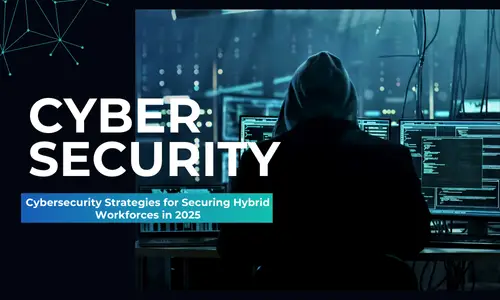Top Cybersecurity Strategies for Securing Hybrid Workforces in 2025

How Generative AI is Transforming Industries in 2025
April 5, 2025
Top Cybersecurity Threats Facing Small Businesses in 2025
April 9, 2025The hybrid workforce model, blending remote and in-office employees, has become a cornerstone of modern business. As we move into 2025, companies face new challenges in protecting sensitive data and systems across diverse environments. Cybersecurity is no longer optional—it’s a critical pillar for ensuring productivity, trust, and compliance in this evolving landscape. With cyber threats growing more sophisticated, organizations must adopt proactive strategies to safeguard their hybrid teams. This blog explores the top cybersecurity strategies to secure hybrid workforces in 2025, offering actionable insights for businesses of all sizes.
Why Cybersecurity Matters for Hybrid Workforces
The shift to hybrid work has expanded the attack surface for cybercriminals. Employees accessing corporate networks from home, coffee shops, or co-working spaces introduce vulnerabilities that traditional office-centric security models can’t fully address. In 2025, ransomware, phishing, and insider threats are expected to surge, targeting the gaps created by distributed teams. A robust cybersecurity framework isn’t just about protecting data—it’s about enabling a workforce that thrives without compromising safety.
1. Implement Zero Trust Architecture
Zero Trust is a game-changer for hybrid workforces. This approach assumes no user or device is inherently trustworthy, requiring continuous verification regardless of location. In 2025, adopting Zero Trust means integrating multi-factor authentication (MFA), identity verification, and least-privilege access controls. By ensuring that only authorized personnel can access specific resources, businesses can minimize risks from compromised credentials—a common entry point for attackers.
To make Zero Trust effective, invest in tools that monitor user behavior and flag anomalies in real time. For example, if an employee logs in from an unusual location or device, the system can prompt additional verification steps. This layered defense is essential for hybrid setups where employees toggle between secure and unsecured networks.
2. Strengthen Endpoint Security
Endpoints—laptops, smartphones, and tablets—are the frontline of hybrid work. Each device is a potential gateway for malware or unauthorized access. Strengthening endpoint security in 2025 involves deploying advanced antivirus software, encryption, and remote wipe capabilities. Additionally, endpoint detection and response (EDR) solutions can identify and neutralize threats before they spread across the network.
Regular updates and patch management are non-negotiable. Cybercriminals often exploit outdated software, so automating updates across all devices ensures consistent protection. Educating employees about safe device usage, like avoiding public Wi-Fi without a VPN, further bolsters this strategy.
3. Prioritize Employee Cybersecurity Training
Human error remains a leading cause of data breaches. In a hybrid workforce, where employees may feel less supervised, the risk of clicking phishing links or mishandling sensitive information rises. Comprehensive cybersecurity training empowers employees to recognize threats and follow best practices. In 2025, make training engaging and ongoing—think interactive modules, simulated phishing exercises, and quarterly refreshers.
Tailor content to hybrid-specific scenarios, such as securing home Wi-Fi or spotting social engineering attempts via video calls. A well-informed team is your first line of defense, reducing the burden on technical safeguards.
4. Leverage Cloud Security Solutions
The cloud is the backbone of hybrid work, hosting collaboration tools, storage, and applications. However, misconfigured cloud settings can expose data to unauthorized access. In 2025, leveraging cloud security solutions means adopting secure access service edge (SASE) frameworks, which combine networking and security into a unified service. SASE ensures that data flowing between employees and cloud platforms remains encrypted and monitored.
Regular audits of cloud permissions also prevent “shadow IT”—unauthorized apps or services that employees might use. Pair this with data loss prevention (DLP) tools to track and protect sensitive information, ensuring compliance with regulations like GDPR or CCPA.
5. Enhance Network Security with VPNs and SD-WAN
Hybrid workers rely on networks that vary in reliability and safety. Virtual private networks (VPNs) encrypt connections, shielding data from prying eyes on public or home Wi-Fi. In 2025, consider upgrading to software-defined wide area networks (SD-WAN), which offer greater flexibility and performance for distributed teams. SD-WAN prioritizes traffic, ensuring secure, seamless access to critical applications.
Monitor network activity for unusual patterns, such as large data transfers outside business hours. Combining these technologies creates a resilient infrastructure that supports productivity without sacrificing security.
6. Adopt AI-Powered Threat Detection
Artificial intelligence (AI) is transforming cybersecurity by identifying threats faster than human analysts can. In 2025, AI-powered tools can analyze vast amounts of data from hybrid environments, spotting ransomware, insider threats, or zero-day exploits in real time. These systems learn from patterns, adapting to new attack methods as they emerge.
Integrate AI with existing security operations to reduce response times. For instance, if an employee’s account shows suspicious activity, AI can automatically lock it and alert IT teams. This proactive approach keeps hybrid workforces ahead of evolving risks.
7. Establish a Robust Incident Response Plan
Even with the best defenses, breaches can happen. A well-defined incident response plan ensures that hybrid teams know how to react swiftly and effectively. In 2025, this plan should account for remote workers, outlining steps like isolating affected devices, notifying stakeholders, and restoring operations from backups.
Test the plan regularly with tabletop exercises that simulate real-world scenarios. Include communication protocols to keep employees informed without causing panic. A prepared organization can mitigate damage and recover faster, maintaining trust with clients and partners.
The Role of Leadership in Cybersecurity Success
Securing a hybrid workforce isn’t just an IT responsibility—it starts at the top. Leaders must champion a security-first culture, allocating budgets for tools, training, and talent. In 2025, C-suite executives should collaborate with IT teams to align cybersecurity goals with business objectives. This top-down approach ensures that security isn’t an afterthought but a strategic priority.
Encourage transparency, too. If a breach occurs, leaders should communicate openly with employees and customers, demonstrating accountability and a commitment to improvement.
Future-Proofing Your Hybrid Workforce
As hybrid work evolves, so will the threats targeting it. Staying ahead requires agility—regularly reassessing risks, updating tools, and refining policies. In 2025, consider partnering with cybersecurity experts to conduct penetration testing or vulnerability assessments. These insights reveal weak spots before attackers can exploit them.
Investing in emerging technologies, like quantum-resistant encryption, can also prepare your organization for the next wave of challenges. The goal is resilience: a workforce that operates confidently, knowing its data and systems are secure.
Conclusion
Securing a hybrid workforce in 2025 demands a multi-faceted approach that blends technology, training, and strategy. From Zero Trust and endpoint security to AI-driven threat detection, these cybersecurity measures protect businesses in an increasingly complex digital world. By prioritizing these strategies, organizations can empower their teams to work flexibly without compromising safety. Start planning today—because in the hybrid era, strong cybersecurity is the foundation of success.


